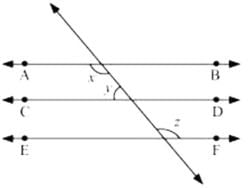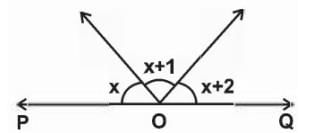Test: Class 9 Math: CBSE Sample Question Paper Term I - 1 - Class 9 MCQ
30 Questions MCQ Test Mathematics (Maths) Class 9 - Test: Class 9 Math: CBSE Sample Question Paper Term I - 1
How many linear equations are satisfied by x = 2 and y = - 3?
| 1 Crore+ students have signed up on EduRev. Have you? Download the App |
In the figure, AB ║CD , What is x + y.


The area of a triangle with base 8 cm and height 10 cm is
Which of the following is a rational number?
The equation 2x + 9 = 0 on number line is represented by:
In the given figure, AB ║ CD, CD ║ EF and y : z = 3 : 7, then x =?

In the given figure, BO and CO are the bisectors of ∠B and ∠C and respectively. If ∠A = 50° then ∠BOC = ?

If 10x = 64, what is the value of  ?
?
In the adjoining figure, y = ?

If g =  , what is the value of g when t = 64?
, what is the value of g when t = 64?
If in the figure, POQ is a straight line. The three adjacent angles are consecutive numbers, the measure of these angles is-

If (a, -2) lies on the graph of 3x - y = 10, then the value of a is
The mid-value of a class interval is 42. If the class size is 10, then the upper and lower limits of the class are:
The sides of a triangle are 35 cm, 54 cm and 61 cm respectively, and its area is 420√5 cm2. The length of its longest altitude is
The algebraic sum of the deviations of a set of n values from their mean is:
In Fig., the value of x, is

The equation 2x + 5y = 7 has a unique solution, if x, y are :
The lengths of the sides of ABCare consecutive integers. It ΔABC has perimeter as an equilateral triangle triangle with a side of length 9 cm, what is the length of the shortest side of ΔABC?
A linear equation in two variables is of the form ax + by + c = 0, where
The co-ordinates of a point above the x-axis lying on y-axis at a distance of 4 units are
If 102y = 25, then 10-y equals
The area of an equilateral triangle is 81√3cm2 . Its height is
In the below figure AB ║ CD ,O is the mid point BC. Which of the following is true?

The point C(-5, -2) lies in
The graph given below shows the frequency distribution of the age of 22 teachers in a school. The number of teachers whose age is less than 40 years is

If side of a scalene Δ is doubled then area would be increased by
|
44 videos|412 docs|54 tests
|
|
44 videos|412 docs|54 tests
|


 =
=






 is
is










 = x + 5 = 42 (given)
= x + 5 = 42 (given)
 be the mean of the n observations q Xi, ..., Xn then we have
be the mean of the n observations q Xi, ..., Xn then we have

 be the mean of n values Xi, ..., Xn. So, we have
be the mean of n values Xi, ..., Xn. So, we have

 is
is =
= 


 = _____________ .
= _____________ .





 is
is











 =
= 










